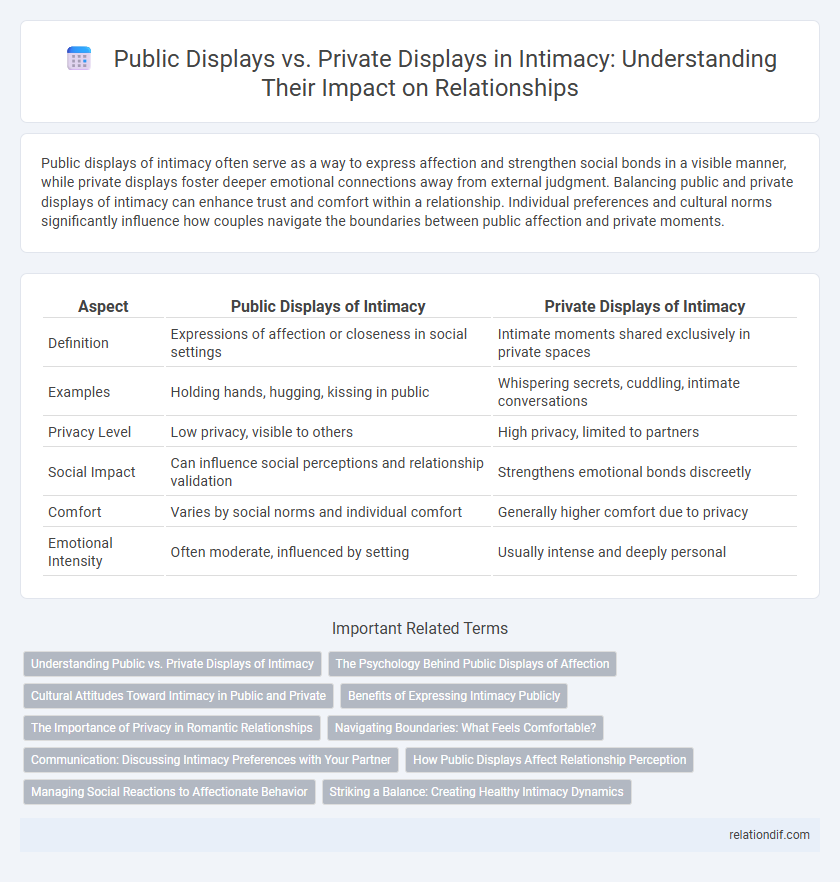Public displays of intimacy often serve as a way to express affection and strengthen social bonds in a visible manner, while private displays foster deeper emotional connections away from external judgment. Balancing public and private displays of intimacy can enhance trust and comfort within a relationship. Individual preferences and cultural norms significantly influence how couples navigate the boundaries between public affection and private moments.
Table of Comparison
| Aspect | Public Displays of Intimacy | Private Displays of Intimacy |
|---|---|---|
| Definition | Expressions of affection or closeness in social settings | Intimate moments shared exclusively in private spaces |
| Examples | Holding hands, hugging, kissing in public | Whispering secrets, cuddling, intimate conversations |
| Privacy Level | Low privacy, visible to others | High privacy, limited to partners |
| Social Impact | Can influence social perceptions and relationship validation | Strengthens emotional bonds discreetly |
| Comfort | Varies by social norms and individual comfort | Generally higher comfort due to privacy |
| Emotional Intensity | Often moderate, influenced by setting | Usually intense and deeply personal |
Understanding Public vs. Private Displays of Intimacy
Public displays of intimacy often involve subtle gestures like hand-holding or brief kisses, reflecting social norms and comfort levels within communal settings. Private displays of intimacy, by contrast, allow for more explicit expressions of affection, fostering deeper emotional connection away from public scrutiny. Understanding the balance between these displays is crucial for respecting personal boundaries while nurturing relational closeness.
The Psychology Behind Public Displays of Affection
Public displays of affection (PDA) reveal underlying psychological needs such as social validation, emotional expression, and relationship signaling. Couples often engage in PDA to communicate commitment and attachment to others, reinforcing a sense of security and belonging. Psychological theories highlight that comfort with PDA varies based on cultural norms, personality traits, and relationship dynamics.
Cultural Attitudes Toward Intimacy in Public and Private
Cultural attitudes toward intimacy in public and private vary significantly across societies, influencing acceptable behaviors such as hugging, kissing, or holding hands. In many Western cultures, public displays of affection (PDA) are generally accepted and seen as expressions of emotional connection, while more conservative societies often reserve intimacy for private settings to uphold social norms and modesty. These differing perspectives highlight the importance of cultural context in shaping how intimacy is expressed and perceived in both public and private spheres.
Benefits of Expressing Intimacy Publicly
Expressing intimacy publicly fosters social bonding and demonstrates relationship commitment, enhancing trust and security between partners. Public displays of affection can boost emotional well-being by validating the relationship in the eyes of others, which strengthens mutual support networks. Such expressions also encourage positive social interactions, reducing feelings of loneliness and promoting a sense of belonging.
The Importance of Privacy in Romantic Relationships
Privacy in romantic relationships fosters deeper emotional connection by allowing couples to express intimacy without external judgment. Private displays of affection create a safe space for vulnerability and trust, essential for relationship growth. Maintaining boundaries in public and private settings helps partners nurture their bond while respecting social norms.
Navigating Boundaries: What Feels Comfortable?
Navigating the boundaries of intimacy requires balancing public displays of affection with private moments that feel comfortable for both partners. Understanding personal and cultural comfort levels helps establish respectful expressions of love without overstepping emotional or social limits. Clear communication about preferences ensures intimacy enhances connection rather than causing discomfort in either public or private settings.
Communication: Discussing Intimacy Preferences with Your Partner
Open communication about intimacy preferences helps partners establish boundaries and understand each other's comfort levels with public displays of affection (PDA) versus private displays. Discussing desires, limits, and emotional responses to various types of physical touch creates a safe space for expressing needs and avoiding misunderstandings. Prioritizing honest dialogue about intimacy strengthens trust and fosters deeper emotional connection in the relationship.
How Public Displays Affect Relationship Perception
Public displays of intimacy, such as holding hands or affectionate gestures, can enhance relationship perception by signaling commitment and emotional connection to others. These displays act as social proof, increasing feelings of security and approval between partners while reinforcing their bond in the eyes of the community. However, excessive or inappropriate public affection may lead to discomfort or social judgment, potentially impacting the relationship's perceived respectability.
Managing Social Reactions to Affectionate Behavior
Managing social reactions to affectionate behavior requires balancing public displays and private displays of intimacy to respect social norms and personal boundaries. Public displays of affection, such as holding hands or brief kisses, are often accepted in many cultures but may provoke discomfort or judgment in more conservative settings, necessitating discretion. Private displays offer greater freedom for expressing intimacy without social scrutiny, allowing couples to strengthen their bond while avoiding potential negative reactions from onlookers.
Striking a Balance: Creating Healthy Intimacy Dynamics
Striking a balance between public displays and private displays of intimacy is essential for fostering healthy relationship dynamics. Couples who openly express affection in private while maintaining respectful boundaries in public strengthen trust and emotional connection. Establishing mutual comfort levels around visibility of intimacy promotes security and nurtures emotional well-being within the partnership.
Public displays vs Private displays Infographic

 relationdif.com
relationdif.com